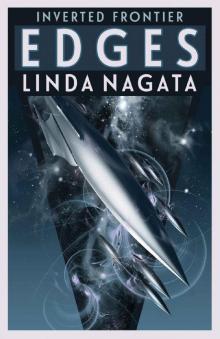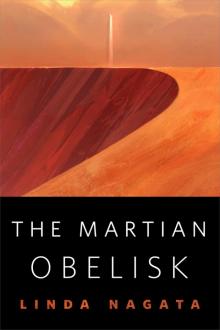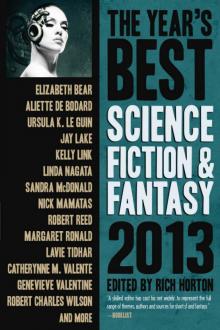- Home
- Linda Nagata
The Martian Obelisk
The Martian Obelisk Read online
Begin Reading
Table of Contents
Copyright Page
Thank you for buying this
Tom Doherty Associates ebook.
To receive special offers, bonus content,
and info on new releases and other great reads,
sign up for our newsletters.
Or visit us online at
us.macmillan.com/newslettersignup
The author and publisher have provided this e-book to you without Digital Rights Management software (DRM) applied so that you can enjoy reading it on your personal devices. This e-book is for your personal use only. You may not print or post this e-book, or make this e-book publicly available in any way. You may not copy, reproduce, or upload this e-book, other than to read it on one of your personal devices.
Copyright infringement is against the law. If you believe the copy of this e-book you are reading infringes on the author’s copyright, please notify the publisher at: us.macmillanusa.com/piracy.
The end of the world required time to accomplish—and time, Susannah reflected, worked at the task with all the leisurely skill of a master torturer, one who could deliver death either quickly or slowly, but always with excruciating pain.
No getting out of it.
But there were still things to do in the long, slow decline; final gestures to make. Susannah Li-Langford had spent seventeen years working on her own offering-for-the-ages, with another six and half years to go before the Martian Obelisk reached completion. Only when the last tile was locked into place in the obelisk’s pyramidal cap, would she yield.
Until then, she did what was needed to hold onto her health, which was why, at the age of eighty, she was out walking vigorously along the cliff trail above the encroaching Pacific Ocean, determined to have her daily exercise despite the brisk wind and the freezing mist that ran before it. The mist was only a token moisture, useless to revive the drought-stricken coastal forest, but it made the day cold enough that the fishing platforms at the cliff’s edge were deserted, leaving Susannah alone to contemplate the mortality of the human world.
It was not supposed to happen like this. As a child she’d been promised a swift conclusion: duck and cover and nuclear annihilation. And if not annihilation, at least the nihilistic romance of a gun-toting, leather-clad, fight-to-the-death anarchy.
That hadn’t happened either.
Things had just gotten worse, and worse still, and people gave up. Not everyone, not all at once—there was no single event marking the beginning of the end—but there was a sense of inevitability about the direction history had taken. Sea levels rose along with average ocean temperatures. Hurricanes devoured coastal cities and consumed low-lying countries. Agriculture faced relentless drought, flood, and temperature extremes. A long run of natural disasters made it all worse—earthquakes, landslides, tsunamis, volcanic eruptions. There had been no major meteor strike yet, but Susannah wouldn’t bet against it. Health care faltered as antibiotics became useless against resistant bacteria. Surgery became an art of the past.
Out of the devastation, war and terrorism erupted like metastatic cancers.
We are a brilliant species, Susannah thought. Courageous, creative, generous—as individuals. In larger numbers we fail every time.
There were reactor meltdowns, poisoned water supplies, engineered plagues, and a hundred other, smaller horrors. The Shoal War had seen nuclear weapons used in the South China Sea. But even the most determined ghouls had failed to ignite a sudden, brilliant cataclysm. The master torturer would not be rushed.
Still, the tipping point was long past, the future truncated. Civilization staggered on only in the lucky corners of the world where the infrastructure of a happier age still functioned. Susannah lived in one of those lucky corners, not far from the crumbling remains of Seattle, where she had greenhouse food, a local network, and satellite access all supplied by her patron, Nathaniel Sanchez, who was the money behind the Martian Obelisk.
When the audio loop on her ear beeped a quiet tone, she assumed the alert meant a message from Nate. There was no one else left in her life, nor did she follow the general news, because what was the point?
She tapped the corner of her wrist-link with a finger gloved against the cold, signaling her personal AI to read the message aloud. Its artificial, androgynous voice spoke into her ear:
“Message sender: Martian Obelisk Operations. Message body: Anomaly sighted. All operations automatically halted pending supervisory approval.”
Just a few innocuous words, but weighted with a subtext of disaster.
A subtext all too familiar.
For a few seconds, Susannah stood still in the wind and the rushing mist. In the seventeen-year history of the project, construction had been halted only for equipment maintenance, and that, on a tightly regulated schedule. She raised her wrist-link to her lips. “What anomaly, Alix?” she demanded, addressing the AI. “Can it be identified?”
“It identifies as a homestead vehicle belonging to Red Oasis.”
That was absurd. Impossible.
Founded twenty-one years ago, Red Oasis was the first of four Martian colonies, and the most successful. It had outlasted all the others, but the Mars Era had ended nine months ago when Red Oasis succumbed to an outbreak of “contagious asthma”—a made-up name for an affliction evolved on Mars.
Since then there had been only radio silence. The only active elements on the planet were the wind, and the machinery that had not yet broken down, all of it operated by AIs.
“Where is the vehicle?” Susannah asked.
“Seventeen kilometers northwest of the obelisk.”
So close!
How was that possible? Red Oasis was over 5,000 kilometers distant. How could an AI have driven so far? And who had given the order?
Homestead vehicles were not made to cover large distances. They were big, slow, and cumbersome—cross-country robotic crawlers designed to haul equipment from the landing site to a colony’s permanent location, where construction would commence (and ideally be completed) long before the inhabitants arrived. The vehicles had a top speed of fifteen kilometers per hour which meant that even with the lightspeed delay, Susannah had time to send a new instruction set to the AIs that inhabited her construction equipment.
Shifting abruptly from stillness to motion, she resumed her vigorous pace—and then she pushed herself to walk just a little faster.
* * *
Nathaniel Sanchez was waiting for her, pacing with a hobbling gait on the front porch of her cottage when she returned. His flawless electric car, an anomaly from another age, was parked in the gravel driveway. Nate was eighty-five and rail-thin, but the electric warmth of his climate-controlled coat kept him comfortable even in the biting wind. She waved at him impatiently. “You know it’s fine to let yourself in. I was hoping you’d have coffee brewing by now.”
He opened the door for her, still a practitioner of the graceful manners instilled in him by his mother eight decades ago—just one of the many things Susannah admired about him. His trustworthiness was another. Though Nate owned every aspect of the Martian Obelisk project—the equipment on Mars, the satellite accounts, this house where Susannah expected to live out her life—he had always held fast to an early promise never to interfere with her design or her process.
“I haven’t been able to talk to anyone associated with Red Oasis,” he told her in a voice low and resonant with age. “The support network may have disbanded.”
She sat down in the old, armless chair she kept by the door, and pulled off her boots. “Have the rights to Red Oasis gone on the market yet?”
“No.” Balancing with one hand against the door, he carefully stepped out of his clogs. “If they had
, I would have bought them.”
“What about a private transfer?”
He offered a hand to help her up. “I’ve got people looking into it. We’ll find out soon.”
In stockinged feet, she padded across the hardwood floor and the hand-made carpets of the living room, but at the door of the Mars room she hesitated, looking back at Nate. Homesteads were robotic vehicles, but they were designed with cabs that could be pressurized for human use, with a life-support system that could sustain two passengers for many days. “Is there any chance some of the colonists at Red Oasis are still alive?” Susannah asked.
Nate reached past her to open the door, a dark scowl on his worn face. “No detectable activity and radio silence for nine months? I don’t think so. There’s no one in that homestead, Susannah, and there’s no good reason for it to visit the obelisk, especially without any notice to us that it was coming. When my people find out who’s issuing the orders we’ll get it turned around, but in the meantime, do what you have to do to take care of our equipment.”
Nate had always taken an interest in the Martian Obelisk, but over the years, as so many of his other aspirations failed, the project had become more personal. He had begun to see it as his own monument and himself as an Ozymandias whose work was doomed to be forgotten, though it would not fall to the desert sands in this lifetime or any other.
* * *
“What can I do for you, Susannah?” he had asked, seventeen years ago.
A long-time admirer of her architectural work, he had come to her after the ruin of the Holliday Towers in Los Angeles—her signature project—two soaring glass spires, one eighty-four floors and the other 104, linked by graceful sky bridges. When the Hollywood Quake struck, the buildings had endured the shaking just as they’d been designed to do, keeping their residents safe, while much of the city around them crumbled. But massive fires followed the quake and the towers had not survived that.
“Tell me what you dream of, Susannah. What you would still be willing to work on.”
Nathaniel had been born into wealth, and through the first half of his life he’d grown the family fortune. Though he had never been among the wealthiest individuals of the world, he could still indulge extravagant fancies.
The request Susannah made of him had been, literally, outlandish.
“Buy me the rights to the Destiny Colony.”
“On Mars?” His tone suggested a suspicion that her request might be a joke.
“On Mars,” she assured him.
Destiny had been the last attempt at Mars colonization. The initial robotic mission had been launched and landed, but money ran out and colonists were never sent. The equipment sat on Mars, unused.
Susannah described her vision of the Martian Obelisk: a gleaming, glittering white spire, taking its color from the brilliant white of the fiber tiles she would use to construct it. It would rise from an empty swell of land, growing more slender as it reached into the sparse atmosphere, until it met an engineering limit prescribed by the strength of the fiber tiles, the gravity of the Red Planet, and by the fierce ghost-fingers of Mars’ storm winds. Calculations of the erosional force of the Martian wind led her to conclude that the obelisk would still be standing a hundred thousand years hence and likely far longer. It would outlast all buildings on Earth. It would outlast her bloodline, and all bloodlines. It would still be standing long after the last human had gone the way of the passenger pigeon, the right whale, the dire wolf. In time, the restless Earth would swallow up all evidence of human existence, but the Martian Obelisk would remain—a last monument marking the existence of humankind, excepting only a handful of tiny, robotic spacecraft faring, lost and unrecoverable, in the void between stars.
Nate had listened carefully to her explanation of the project, how it could be done, and the time that would be required. None of it fazed him and he’d agreed, without hesitation, to support her.
The rights to the colony’s equipment had been in the hands of a holding company that had acquired ownership in bankruptcy court. Nathaniel pointed out that no one was planning to go to Mars again, that no one any longer possessed the wealth or resources to try. Before long, he was able to purchase Destiny Colony for a tiny fraction of the original backers’ investment.
When Susannah received the command codes, Destiny’s homestead vehicle had not moved from the landing site, its payload had not been unpacked, and construction on its habitat had never begun. Her first directive to the AI in charge of the vehicle was to drive it three hundred kilometers to the site she’d chosen for the obelisk, at the high point of a rising swell of land.
Once there, she’d unloaded the fleet of robotic construction equipment: a mini-dozer, a mini-excavator, a six-limbed beetle cart to transport finished tiles, and a synth—short for synthetic human although the device was no such thing. It was just a stick figure with two legs, two arms, and hands capable of basic manipulation.
The equipment fleet also included a rolling factory that slowly but continuously produced a supply of fiber tiles, compiling them from raw soil and atmospheric elements. While the factory produced an initial supply of tiles, Susannah prepared the foundation of the obelisk, and within a year she began to build.
The Martian Obelisk became her passion, her reason for life after every other reason had been taken from her. Some called it a useless folly. She didn’t argue: what meaning could there be in a monument that would never be seen directly by human eyes? Some called it graffiti: Kilroy was here! Some called it a tombstone and that was the truth too.
Susannah just called it better-than-nothing.
* * *
The Mars room was a circular extension that Nathaniel had ordered built onto the back of the cottage when Susannah was still in the planning stages of the obelisk’s construction. When the door was closed, the room became a theater with a 360-degree floor-to-ceiling flex-screen. A high-backed couch at the center rotated, allowing easy viewing of the encircling images captured in high resolution from the construction site.
Visually, being in this room was like being at Destiny, and it did not matter at all that each red-tinted image was a still shot, because on the Red Planet, the dead planet, change came so slowly that a still shot was as good as video.
Until now.
As Susannah entered the room, she glimpsed an anomalous, bright orange spot in a lowland to the northwest. Nathaniel saw it too. He gestured and started to speak but she waved him to silence, taking the time to circle the room, scanning the entire panorama to assess if anything else had changed.
Her gaze passed first across a long slope strewn with a few rocks and scarred with wheel tracks. Brightly colored survey sticks marked the distance: yellow at 250 meters, pink at 500, green for a full kilometer, and bright red for two.
The red stick stood at the foot of a low ridge that nearly hid the tile factory. She could just see an upper corner of its bright-green, block shape. The rest of it was out of sight, busy as always, processing raw ore dug by the excavator from a pit beyond the ridge, and delivered by the mini-dozer. As the factory slowly rolled, it left a trail of tailings, and every few minutes it produced a new fiber tile.
Next in the panorama was a wide swath of empty land, more tire tracks the only sign of human influence all the way out to a hazy pink horizon. And then, opposite the door and appearing no more than twenty meters distant, was Destiny’s homestead vehicle. It was the same design as the approaching crawler: a looming cylindrical cargo container resting on dust-filled tracks. At the forward end, the cab, its windows dusty and lightless, its tiny bunkroom never used. Susannah had long ago removed the equipment she wanted, leaving all else in storage. For over sixteen years, the homestead had remained in its current position, untouched except by the elements.
Passing the Destiny homestead, her gaze took in another downward slope of lifeless desert and then, near the end of her circuit, she faced the tower itself.
The Martian Obelisk stood alone at the high point of the
surrounding land, a gleaming-white, graceful, four-sided, tapering spire, already 170-meters high, sharing the sky with no other object. The outside walls were smooth and unadorned, but on the inside, a narrow stairway climbed around the core, rising in steep flights to the tower’s top, where more fiber tiles were added every day, extending its height. It was a path no human would ever walk, but the beetle cart, with its six legs, ascended every few hours, carrying in its cargo basket a load of fiber tiles. Though she couldn’t see the beetle cart, its position was marked as inside the tower, sixty percent of the way up the stairs. The synth waited for it at the top, its headless torso just visible over the rim of the obelisk’s open stack, ready to use its supple hands to assemble the next course of tiles.
All this was as expected, as it should be.
Susannah steadied herself with a hand against the high back of the couch as she finally considered the orange splash of color that was the intruding vehicle. “Alix, distance to the Red Oasis homestead?”
The same androgynous voice that inhabited her ear loop spoke now through the room’s sound system. “Twelve kilometers.”
The homestead had advanced five kilometers in the twenty minutes she’d taken to return to the cottage—though in truth it was really much closer. Earth and Mars were approaching a solar conjunction, when they would be at their greatest separation, on opposite sides of the Sun. With the lightspeed delay, even this new image was nineteen minutes old. So she had only minutes left to act.
Reaching down to brace herself against the armrest of the couch, she sat with slow grace. “Alix, give me a screen.”
A sleeve opened in the armrest and an interface emerged, swinging into an angled display in front of her.
The fires that had destroyed the Holliday Towers might have been part of the general inferno sparked by the Hollywood earthquake, but Susannah suspected otherwise. The towers had stood as a symbol of defiance amid the destruction—which might explain why they were brought low. The Martian Obelisk was a symbol too, and it had long been a target both for the media and for some of Destiny’s original backers who had wanted the landing left undisturbed, for the use of a future colonization mission that no one could afford to send.

 Nightside on Callisto and Other Stories
Nightside on Callisto and Other Stories Pacific Storm
Pacific Storm Edges
Edges The Red
The Red The Red: First Light
The Red: First Light The Martian Obelisk
The Martian Obelisk Limit of Vision
Limit of Vision Going Dark
Going Dark The Last Good Man
The Last Good Man The Trials (The Red Trilogy Book 2)
The Trials (The Red Trilogy Book 2) Deception Well (The Nanotech Succession Book 2)
Deception Well (The Nanotech Succession Book 2) The Year's Best Science Fiction & Fantasy 2013
The Year's Best Science Fiction & Fantasy 2013 The Dread Hammer
The Dread Hammer Skye Object 3270a
Skye Object 3270a The Bohr Maker
The Bohr Maker